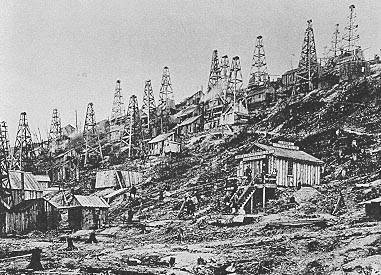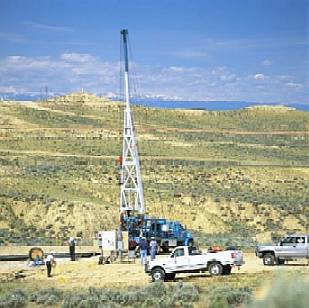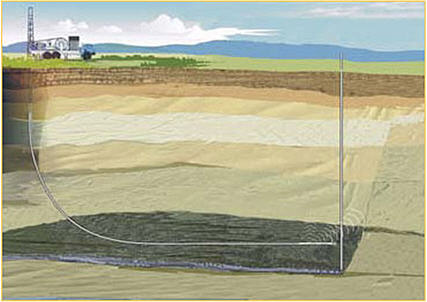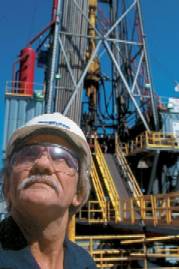Onshore Drilling
Drilling into the Earth in the hopes of uncovering valuable resources is nothing new. In fact, the digging of water and irrigation wells dates back to the beginning of recorded history. At first, these wells were primarily dug by hand, then by crude stone or wood tools. Metallurgy brought about the use of iron and bronze tools to delve beneath the Earth’s surface, and innovations led to more efficient ways of removing debris from the newly dug hole. The first recorded instance of the practice of ‘drilling’ holes in the ground came about around 600 B.C., when the Chinese developed a technique of repeatedly pounding bamboo shoots capped with metal bits into the ground. This crude technology was the first appearance of what is known today as ‘percussion drilling,’ a method of drilling that is still in use. Much advancement has been made since these first bamboo drilling implements. This section will cover the basics of modern onshore natural gas drilling practices.
There are two main types of onshore drilling. Percussion, or ‘cable tool’ drilling, consists of raising and dropping a heavy metal bit into the ground, effectively punching a hole down through the earth. Cable tool drilling is usually used for shallow, low pressure formations. The second drilling method is known as rotary drilling, and consists of a sharp, rotating metal bit used to drill through the Earth’s crust. This type of drilling is used primarily for deeper wells, which may be under high pressure.
Cable Tool Drilling
Cable tool, or percussion drilling, is recognized by many as the first drilling method employed to dig wells into the earth for the purpose of reaching petroleum deposits and water. This method is still in use in some of the shallow wells in the Appalachian Basin, although rotary drilling has taken over the bulk of modern drilling activities.
The basic concept for cable tool drilling consists of repeatedly dropping a heavy metal bit into the ground, eventually breaking through rock and punching a hole through to the desired depth. The bit, usually a blunt, chisel shaped instrument, can vary with the type of rock that is being drilled. Water is used in the well hole to combine with all of the drill cuttings, and is periodically bailed out of the well when this ‘mud’ interferes with the effectiveness of the drill bit.
 |
| Early Percussion Rigs in Pennsylvania – Late 1800’s |
| Source: Office of Fossil Energy, DOE |
Cable tool drilling has historically taken many forms. In the early days of percussion drilling, equipment was very crude compared to today’s technology. The ‘springpole’ technique, used in the early 1800s, consisted of a flexible pole (usually a tree trunk) anchored at one end, and laying across a fulcrum, much like a diving board. The flexible pole, or springpole, would have a heavy bit attached at the loose end. In order to get the bit to strike the ground, workers would use their own body weight to bend the pole toward the ground, allowing the bit to strike rock. The tension in the pole would spring the bit free, in case it became stuck in the ground.
Many improvements have been made since these early percussion rigs. In fact, it was from cable tool drilling that one of the most important drilling advancements was made. In 1806, David and Joseph Ruffner were using the springpole technique to drill a well in West Virginia. In order to prevent their well from collapsing, they used hollow tree trunks to reinforce the sides of the well, and to keep water and mud from entering the well as they dug. They are credited as the first drillers to use a casing in their well – an advancement that made drilling much more efficient and easily accomplished. It is believed by many that ‘Colonel’ Drake’s 1856 well achieved success due to the use of steel casing to reinforce the well. Drake’s well was drilled using steam powered cable tool drilling methods. For more information on well casings, and well completion, click here.
 |
| A Modern, Mobile Cable Tool Drilling Rig |
| Source: Anadarko Petroleum Corporation |
Innovations, such as the use of steam power in cable tool drilling, greatly increased the efficiency and range of percussion drilling. Conventional man-powered cable tool rigs were generally used to drill wells 200 feet or less, while steam powered cable tool rigs, consisting of the familiar derrick design, had an average drilling depth of 400 to 500 feet. The deepest known well dug with cable tool drilling was completed in 1953, when the New York Natural Gas Corporation drilled a well to a depth of 11,145 feet.
Despite the historical significance of cable tool drilling, modern drilling activity has shifted mainly toward rotary drilling methods. However, the foundation of knowledge laid by years of cable tool drilling is, in many cases, directly transferable to the practice of rotary drilling.
Horizontal Drilling
Horizontal drilling is flexible in that it allows for the extraction of natural gas that had previously not been feasible. Although on the surface it resembles a vertical well, beneath the surface, the well inclines so that it runs parallel to the natural gas formation. These legs can go in different directions at different depths and can be more than one mile long horizontally, in addition to the vertical well that can be thousands of feet below the surface. Horizontal drilling allows one surface well to branch out underground and tap many different natural gas resources. It also allows the well to make contact with larger areas within productive formations.
 |
| Horizontal Well and Drill |
| Source: National Energy Technology Laboratory, DOE |
As of result of advances in horizontal drilling natural gas resources in shale basins has been more accessible leading to more diversified sources of natural gas. Combining this with other technologies such as seismic imaging has contributed to lower marginal operating and capital costs, which in turn allow natural gas producers to more economically extract natural gas from resources.
Horizontal drilling also permits the development of natural resources with minimal aboveground disturbance, reducing the environmental footprint of natural gas operations and the cost and potential disturbance of existing roads or other infrastructure. Directional drilling and horizontal drilling terms are often used interchangeably. Directional drilling refers to drilling at a slant or angle to increase contact with the resource. Horizontal drilling is a type of directional drilling. Horizontal drilling uses a technique known as hydraulic fracturing in order to extract natural gas from geologic formations. For more information please visit our hydraulic fracturing section.
